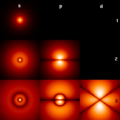Hilbert space

A Hilbert space is a mathematical concept covering the extra-dimensional use of Euclidean space in more than three dimensions. A Hilbert space uses the mathematics of two and three dimensions to describe outcomes in more than three dimensions. It is named after David Hilbert.
Vector algebra and calculus are methods normally used in the two-dimensional Euclidean plane and three-dimensional space. In Hilbert spaces these methods can be used with any finite or infinite number of dimensions. A Hilbert space is a vector space that has the structure of an inner product that allows length and angle to be measured. Hilbert spaces also have to be complete, which means that enough limits have to exist for calculus to work.
The earliest Hilbert spaces were studied in the first decade of the 20th century by David Hilbert, Erhard Schmidt, and Frigyes Riesz. John von Neumann first came up with the name "Hilbert Space". Hilbert space methods made a big difference to functional analysis.
Hilbert spaces show up a lot in mathematics, physics, and engineering, often as infinite-dimensional function spaces. They are especially useful for studying partial differential equations, quantum mechanics, and Fourier analysis (which includes signal processing and heat transfer). Hilbert spaces are used in ergodic theory which is the mathematical basis of thermodynamics. All normal Euclidean spaces are also Hilbert spaces. Other examples of Hilbert spaces include spaces of square-integrable functions, spaces of sequences, Sobolev spaces made up of generalized functions, and Hardy spaces of holomorphic functions.
Hilbert Space Media
The state of a vibrating string can be modeled as a point in a Hilbert space. The decomposition of a vibrating string into its vibrations in distinct overtones is given by the projection of the point onto the coordinate axes in the space.
Completeness means that a series of vectors (in blue) results in a well-defined net displacement vector (in orange).
The path of a billiard ball in the Bunimovich stadium is described by an ergodic dynamical system.
Spherical harmonics, an orthonormal basis for the Hilbert space of square-integrable functions on the sphere, shown graphed along the radial direction
The orbitals of an electron in a hydrogen atom are eigenfunctions of the energy.
References
- Bachman, George; Narici, Lawrence; Beckenstein, Edward (2000), Fourier and wavelet analysis, Universitext, Berlin, New York: Springer-Verlag, ISBN 978-0-387-98899-3, MR 1729490.
- Bers, Lipman; John, Fritz; Schechter, Martin (1981), Partial differential equations, American Mathematical Society, ISBN 0821800493.
- Bourbaki, Nicolas (1986), Spectral theories, Elements of mathematics, Berlin: Springer-Verlag, ISBN 0201007673.
- Bourbaki, Nicolas (1987), Topological vector spaces, Elements of mathematics, Berlin: Springer-Verlag, ISBN 978-3540136279.
- Boyer, Carl Benjamin; Merzbach, Uta C (1991), A History of Mathematics (2nd ed.), John Wiley & Sons, Inc., ISBN 0-471-54397-7.
- Brenner, S.; Scott, R. L. (2005), The Mathematical Theory of Finite Element Methods (2nd ed.), Springer, ISBN 0-3879-5451-1.
- Buttazzo, Giuseppe; Giaquinta, Mariano; Hildebrandt, Stefan (1998), One-dimensional variational problems, Oxford Lecture Series in Mathematics and its Applications, vol. 15, The Clarendon Press Oxford University Press, ISBN 978-0-19-850465-8, MR 1694383.
- Lua error in Module:Citation/CS1/Identifiers at line 630: attempt to index field 'known_free_doi_registrants_t' (a nil value)..
- Courant, Richard; Hilbert, David (1953), Methods of Mathematical Physics, Vol. I, Interscience.
- Dieudonné, Jean (1960), Foundations of Modern Analysis, Academic Press.
- Dirac, P.A.M. (1930), The Principles of Quantum Mechanics, Oxford: Clarendon Press.
- Dunford, N.; Schwartz, J.T. (1958), Linear operators, Parts I and II, Wiley-Interscience.
- Duren, P. (1970), Theory of Hp-Spaces, New York: Academic Press.
- Folland, Gerald B. (2009), Fourier analysis and its application (Reprint of Wadsworth and Brooks/Cole 1992 ed.), American Mathematical Society Bookstore, ISBN 978-0821847909.
- Folland, Gerald B. (1989), Harmonic analysis in phase space, Annals of Mathematics Studies, vol. 122, Princeton University Press, ISBN 0-691-08527-7.
- Fréchet, Maurice (1907), "Sur les ensembles de fonctions et les opérations linéaires", C. R. Acad. Sci. Paris, 144: 1414–1416.
- Fréchet, Maurice (1904–1907), Sur les opérations linéaires.
- Giusti, Enrico (2003), Direct Methods in the Calculus of Variations, World Scientific, ISBN 981-238-043-4.
- Grattan-Guinness, Ivor (2000), The search for mathematical roots, 1870–1940, Princeton Paperbacks, Princeton University Press, ISBN 978-0-691-05858-0, MR 1807717.
- Halmos, Paul (1957), Introduction to Hilbert Space and the Theory of Spectral Multiplicity, Chelsea Pub. Co
- Halmos, Paul (1982), A Hilbert Space Problem Book, Springer-Verlag, ISBN 0387906851.
- Hewitt, Edwin; Stromberg, Karl (1965), Real and Abstract Analysis, New York: Springer-Verlag.
- Lua error in Module:Citation/CS1/Identifiers at line 630: attempt to index field 'known_free_doi_registrants_t' (a nil value).[dead link].
- Lua error in Module:Citation/CS1/Identifiers at line 630: attempt to index field 'known_free_doi_registrants_t' (a nil value)..
- Kadison, Richard V.; Ringrose, John R. (1997), Fundamentals of the theory of operator algebras. Vol. I, Graduate Studies in Mathematics, vol. 15, Providence, R.I.: American Mathematical Society, ISBN 978-0-8218-0819-1, MR 1468229.
- Lua error in Module:Citation/CS1/Identifiers at line 630: attempt to index field 'known_free_doi_registrants_t' (a nil value)..
- Kline, Morris (1972), Mathematical thought from ancient to modern times, Volume 3 (3rd ed.), Oxford University Press (published 1990), ISBN 978-0195061376.
- Kolmogorov, Andrey; Fomin, Sergei V. (1970), Introductory Real Analysis (Revised English edition, trans. by Richard A. Silverman (1975) ed.), Dover Press, ISBN 0-486-61226-0.
- Krantz, Steven G. (2002), Function Theory of Several Complex Variables, Providence, R.I.: American Mathematical Society, ISBN 978-0-8218-2724-6.
- Lanczos, Cornelius (1988), Applied analysis (Reprint of 1956 Prentice-Hall ed.), Dover Publications, ISBN 048665656X.
- Lua error in Module:Citation/CS1/Identifiers at line 630: attempt to index field 'known_free_doi_registrants_t' (a nil value)..
- O'Connor, John J (1996). "Abstract linear spaces". MacTutor History of Mathematics archive.
{{cite encyclopedia}}: Unknown parameter|coauthors=ignored (|author=suggested) (help). - Lebesgue, Henri (1904), Leçons sur l'intégration et la recherche des fonctions primitives, Gauthier-Villars.
- B.M. Levitan (2001), "Hilbert space", in Hazewinkel, Michiel (ed.), Encyclopedia of Mathematics, Springer, ISBN 978-1-55608-010-4[dead link].
- Marsden, Jerrold E. (1974), Elementary classical analysis, W. H. Freeman and Co., MR 0357693.
- Prugovečki, Eduard (1981), Quantum mechanics in Hilbert space (2nd ed.), Dover (published 2006), ISBN 978-0486453279.
- Reed, Michael; Simon, Barry (1980), Functional Analysis, Methods of Modern Mathematical Physics, Academic Press, ISBN 0-12-585050-6.
- Reed, Michael; Simon, Barry (1975), Fourier Analysis, Self-Adjointness, Methods of Modern Mathematical Physics, Academic Press, ISBN 0-12-585002-6.
- Riesz, Frigyes (1907), "Sur une espèce de Géométrie analytique des systèmes de fonctions sommables", C. R. Acad. Sci. Paris, 144: 1409–1411.
- Riesz, Frigyes (1934), "Zur Theorie des Hilbertschen Raumes", Acta Sci. Math. Szeged, 7: 34–38.
- Riesz, Frigyes; Sz.-Nagy, Béla (1990), Functional analysis, Dover, ISBN 0-486-66289-6.
- Rudin, Walter (1973), Functional analysis, Tata MacGraw-Hill.
- Rudin, Walter (1987), Real and Complex Analysis, McGraw-Hill, ISBN 0-07-100276-6.
- Saks, Stanisław (2005), Theory of the integral (2nd Dover ed.), Dover, ISBN 978-0486446486; originally published Monografje Matematyczne, vol. 7, Warszawa, 1937.
- Lua error in Module:Citation/CS1/Identifiers at line 630: attempt to index field 'known_free_doi_registrants_t' (a nil value)..
- Shubin, M. A. (1987), Pseudodifferential operators and spectral theory, Springer Series in Soviet Mathematics, Berlin, New York: Springer-Verlag, ISBN 978-3-540-13621-7, MR 0883081.
- Sobrino, Luis (1996), Elements of non-relativistic quantum mechanics, River Edge, NJ: World Scientific Publishing Co. Inc., Bibcode:1996lnrq.book.....S, ISBN 9789810223861, MR 1626401.
- Stewart, James (2006), Calculus: Concepts and Contexts (3rd ed.), Thomson/Brooks/Cole.
- Stein, E (1970), Singular Integrals and Differentiability Properties of Functions, Princeton Univ. Press, ISBN 0-691-08079-8.
- Stein, Elias; Weiss, Guido (1971), Introduction to Fourier Analysis on Euclidean Spaces, Princeton, N.J.: Princeton University Press, ISBN 978-0-691-08078-9.
- Streater, Ray; Wightman, Arthur (1964), PCT, Spin and Statistics and All That, W. A. Benjamin, Inc.
- Titchmarsh, Edward Charles (1946), Eigenfunction expansions, part 1, Oxford University: Clarendon Press.
- Trèves, François (1967), Topological Vector Spaces, Distributions and Kernels, Academic Press.
- Lua error in Module:Citation/CS1/Identifiers at line 630: attempt to index field 'known_free_doi_registrants_t' (a nil value)..
- von Neumann, John (1932), "Physical Applications of the Ergodic Hypothesis", Proc Natl Acad Sci USA, 18 (3): 263–266, Bibcode:1932PNAS...18..263N, doi:10.1073/pnas.18.3.263, JSTOR 86260, PMC 1076204, PMID 16587674.
- von Neumann, John (1955), Mathematical foundations of quantum mechanics, Princeton Landmarks in Mathematics, Princeton University Press (published 1996), ISBN 978-0-691-02893-4, MR 1435976.
- Warner, Frank (1983), Foundations of Differentiable Manifolds and Lie Groups, Berlin, New York: Springer-Verlag, ISBN 978-0-387-90894-6.
- Weidmann, Joachim (1980), Linear operators in Hilbert spaces, Graduate Texts in Mathematics, vol. 68, Berlin, New York: Springer-Verlag, ISBN 978-0-387-90427-6, MR 0566954.
- Weyl, Hermann (1931), The Theory of Groups and Quantum Mechanics (English 1950 ed.), Dover Press, ISBN 0-486-60269-9.
- Young, Nicholas (1988), An introduction to Hilbert space, Cambridge University Press, ISBN 0-521-33071-8, Zbl 0645.46024.
Other websites
| The English Wikibooks has more information on: |








